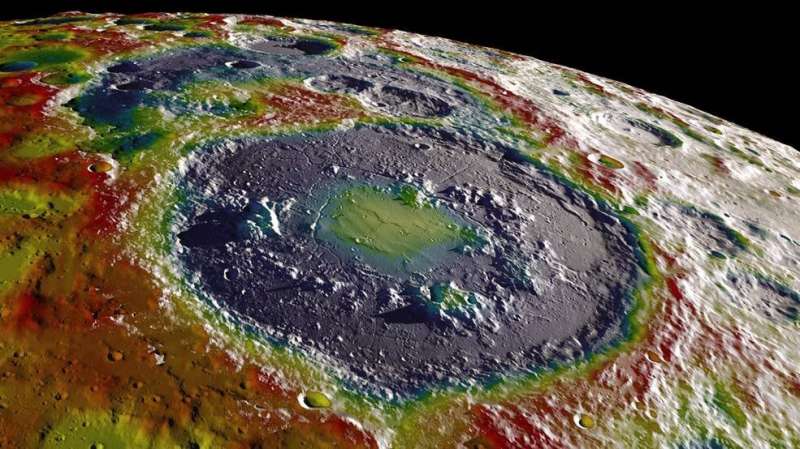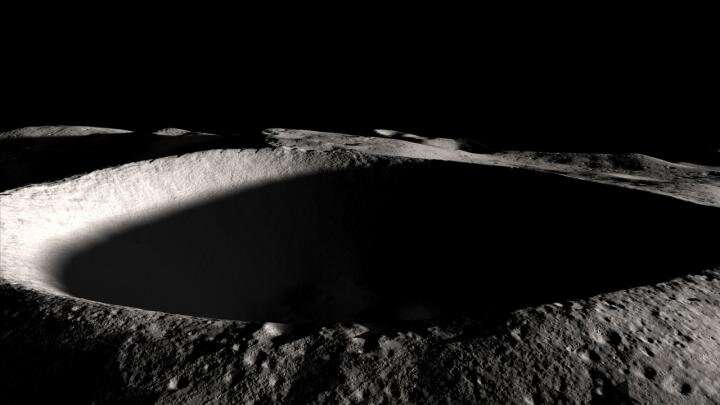Inside dark, polar moon craters, water not as invincible as expected, scientists argue

The Moon's south pole region is home to some of the most extreme environments in the solar system: it's unimaginably cold, massively cratered, and has areas that are either constantly bathed in sunlight or in darkness. This is precisely why NASA wants to send astronauts there in 2024 as part of its Artemis program.
The most enticing feature of this southernmost region is the craters, some of which never see the light of day reach their floors. The reason for this is the low angle of sunlight striking the surface at the poles. To a person standing at the lunar south pole, the Sun would appear on the horizon, illuminating the surface sideways, and, thus, skimming primarily the rims of some craters while leaving their deep interiors in shadow.
As a result of the permanent darkness, NASA's Lunar Reconnaissance Orbiter (LRO) has measured the coldest temperatures in the solar system inside these craters, which have become known as perfect environments for preserving material like water for eons. Or so we thought.
It turns out that despite temperature that dips to -388 degrees Fahrenheit (-233 Celsius) and can presumably keep frost locked in soil virtually forever, water is slowly escaping the topmost, super thin layer (thinner than the width of a red blood cell) of the Moon's surface. NASA scientists reported this finding recently in paper in the journal Geophysical Research Letters.
"People think of some areas in these polar craters as trapping water and that's it," said William M. Farrell, a plasma physicist at NASA's Goddard Space Flight Center in Greenbelt, Maryland, who led the lunar frost research. "But there are solar wind particles and meteoroids hitting the surface, and they can drive reactions that typically occur at warmer surface temperatures. That's something that's not been emphasized."
Unlike Earth, with its plush atmosphere, the Moon has no atmosphere to protect its surface. So when the Sun sprays charged particles known as the solar wind into the solar system, some of them bombard the Moon's surface and kick up water molecules that bounce around to new locations.
Likewise, wayward meteoroids constantly smash into the surface and uproot soil mingled with frozen bits of water. Meteoroids can hurtle these soil particles—which are many times smaller than the width of a human hair—as far as 19 miles (30 kilometers) away from the impact site, depending on the size of the meteoroid. The particles can travel so far because the Moon has low gravity and no air to slow things down: "So every time you have one of these impacts, a very thin layer of ice grains is spread across the surface, exposed to the heat of the Sun and to the space environment, and eventually sublimated or lost to other environmental processes," said Dana Hurley, a planetary scientist at the Johns Hopkins University Applied Physics Laboratory in Laurel, Maryland.
While it's important to consider that even in the shadowed craters water is slowly seeping out, it's possible that water is being added, too, the paper authors note. Icy comets that crash into the Moon, plus the solar wind, could be replenishing it as part of a global water cycle; that's something scientists are trying to figure out. Additionally, it's not clear how much water there is. Is it sitting only in the top layer of the Moon's surface or does it extend deep into the Moon's crust, scientists wonder?
Either way, the topmost layer of polar crater floors is getting reworked over thousands of years, according to calculations by Farrell, Hurley, and their team. Therefore, the faint patches of frost that scientists have detected at the poles using instruments such as LRO's Lyman Alpha Mapping Project (LAMP) instrument could be just 2,000 years old, instead of millions or billions of years old as some might expect, Farrell's team estimated. "We can't think of these craters as icy dead spots," he noted.

To confirm his team's calculations, Farrell said, a future instrument capable of detecting water vapor should find, above the Moon's surface, one to 10 water molecules per cubic centimeter that have been liberated by impacts.
The Good News for Future Lunar Exploration
For forthcoming science and exploration, the scattering of water particles could be great news. It means astronauts may need not to subject themselves and their instruments to the harsh environment of shadowed crater floors in order to find water-rich soil—they could just find it in sunny regions nearby.
"This research is telling us that meteoroids are doing some of the work for us and transporting material from the coldest places to some of the boundary regions where astronauts can access it with a solar-powered rover," Hurley said. "It's also telling us that what we need to do is get on the surface of one of these regions and get some firsthand data about what's happening."
Getting to the lunar surface would make it much easier to assess how much water is on the Moon. Because identifying water from afar, particularly in permanently shadowed craters, is tricky business. The primary way that scientists find water is through remote sensing instruments that can identify what chemical elements things are made of based on the light they reflect or absorb. "But for that, you need a light source," Hurley said. "And by definition, these permanently shadowed regions don't have a strong one."
Understanding the Water Environment on the Moon
Until NASA astronauts get back to the Moon to dig up some soil, or the agency sends new instruments near the surface that can sniff out floating water molecules, the research team's theory about the influence of meteoroids on the environment inside shadowed craters could help chip away at some of the mysteries surrounding the Moon's water. It already has helped scientists understand if the uppermost surface water is new or ancient, or how it may migrate around the Moon. Another thing meteoroid impacts to the crater floors could help explain is why scientists are finding patches of wispy frost diluted in regolith, or Moon soil, rather than blocks of pure water ice.
Even though water questions abound, it's important to remember, Farrell said, that it was only in the last decade that scientists found evidence that the Moon is not a dry, dead rock, as many had long assumed. The LRO, with its thousands of orbits and 1 petabyte of returned science data (equivalent to about 200,000, high-definition, feature-length films streamed online), has been instrumental. So has the Lunar Crater Observation and Sensing Satellite (LCROSS), which revealed frozen water after purposely crashing into Cabeus crater in 2009 and releasing a plume of preserved material from the crater floor that included water.
"We suspected there was water at the poles and learned for sure from LCROSS, but we now have evidence that there's water at mid latitudes," Farrell said. "We also have evidence that there's water coming from micrometeoroid impacts, and we have measurements of frost. But the question is, how are all these water sources related?"
That's a question Farrell and his colleagues are closer to answering than ever before.
More information: W.M. Farrell et al. The Young Age of the LAMP‐observed Frost in Lunar Polar Cold Traps, Geophysical Research Letters (2019). DOI: 10.1029/2019GL083158
Journal information: Geophysical Research Letters
Provided by NASA's Goddard Space Flight Center





















